

The Tigre people are an ethnic group indigenous to Eritrea. They mainly inhabit the lowlands and northern highlands of Eritrea.
They are related to the Biher-Tigrinya of Eritrea and to the Beja people of Sudan. They are mostly Muslims and they are distinguished from other regional peoples by the fact that they possess hereditary slaves. Historically, most of the Tigre have been scattered between Eritrea's northern highlands and western lowlands. They have somewhat shifted into Sudan in search of water and grazing lands. |
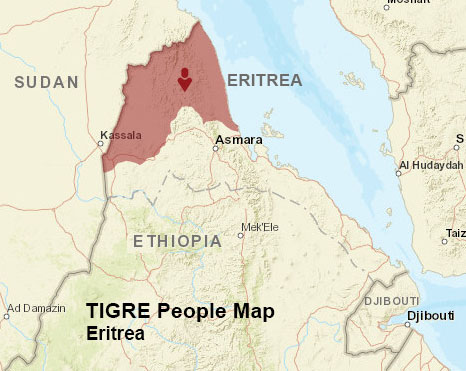 |
The Tigre are one of the nine Eritrean ethnic groups. They constitute 30% of the total Eritrean population and are believed to be a mix of Habesha peoples with later Beja and Arab immigrants. They live on the coastal plain north of the Gulf of Zula, in all the northern highlands and much of the Gash-Barka region.
Tigre clans, some of which are bilingual speaking Arabic and Beja, include:
Most are herders and seasonal farmers, cultivating maize, sorghum, millet and other cereals during the rainy season before moving to grazing areas with their herds. Camels and donkeys are mainly used as means of transportation. The Tigre ethnic group have a rich oral literature of fairy tales, fables, riddles, poetry and stories of different events. They are also known for their singing and dancing, which is usually accompanied by a drum and a mesenko, a stringed instrument, plucked like a guitar.
About 95% of Tigre practice Islam, the remainder practice Christianity, and both incorporate elements of the animist folk religion. Religious divisions have not been of particular concern within the Tigre. Most are Sunni Muslims, but there are a small number of Christians (who are members of the Eritrean Orthodox Tewahedo Church, the Roman Catholic Church, and the Evangelical Lutheran Church of Eritrea) among them as well (often referred to as the Mensaï in Eritrea).
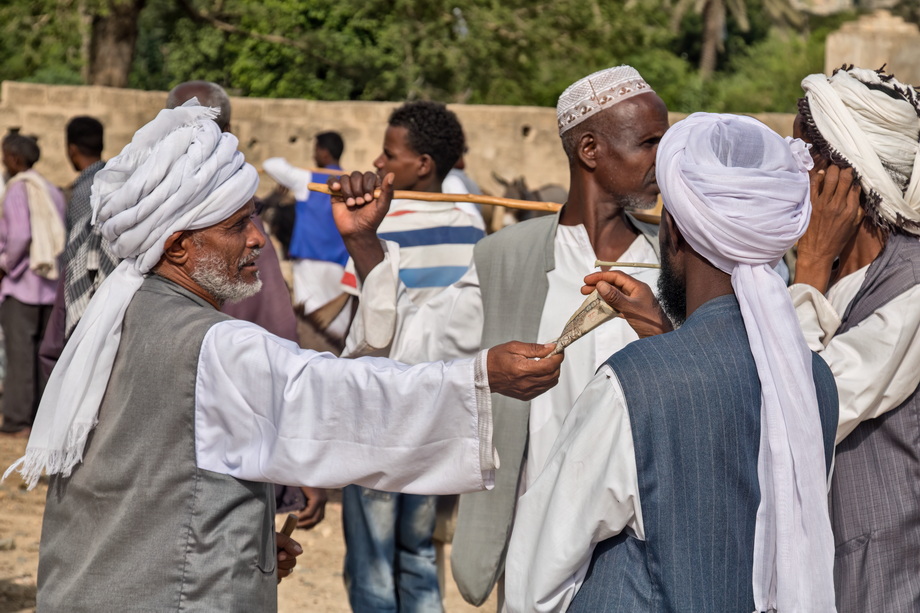
Among the Tigre, the parents arrange marriages for their children. The Tigre are bound by tradition and ignore modern customs such as the romantic acquaintances normally made between two lovers before marriage. It is even common practice among some Tigre communities to conduct marriage by proxy, whereby a boy can have a girl whom he has barely seen all his life.
The entire village, in an act of selfless cooperation and generosity, makes most wedding preparations. Most of the time, it is the father of the boy who asks the father of the girl if the latter is ready to give his daughter’s hand for marriage on a fixed day. The date is generally arrived at by consulting the priests and diviners of the area. The wedding day can, however, be held in any month except June, a month which marks the death of prophet Mohammed.
Since it is the father of the bride who pays the dowry, he chooses a suitable day for the occasion, he prepares a feast and sends for the father of the girl to come and take the dowry, which consists of 3 heads of cattle.
After the dowry handover ceremony, the father of the girl returns home with those who had accompanied him to the feast. However, the father of the girl is also expected by tradition to return, in his own good time, some of the cattle, as part of the dowry that is expected from him.
When the wedding feast is one week away, people start celebrating by singing and dancing. And in their singing, they always praise and eulogize the two families along with the bride and groom. The few days before the wedding is, however, the most demanding time for the bride-to-be. She has to eat less and less and go down to the stream to sing and bathe and get ready for the big day.
Among the Tigre ethnic group, the last-born gets special privileges and shoulders special responsibilities. The last-born, is the youngest child of the first legal wife. This child has the responsibility to look after his mother who remains alone in the house after the death of her husband. And in addition to the shares he gets along with his brothers after the death of his father, he gets the house as inheritance.
Among some Tigre clans, the last-born even gets extra privileges such as the most fertile plot of land, farming tools and a calf of his own choice. In most clans of the Tigre, the council of elders, which undertakes the sharing of the inheritance, is composed of three persons. Sometimes, a sheikh is added to the council. In the event that the council and sheikh are unable to solve the problem, the case devolves to the khaddi. The latter is entitled to a tenth part of the shares after settling the case.
As to the custody of the goods to be inherited, they are kept with the first-born until such time that the case of inheritance is settled once and for all.
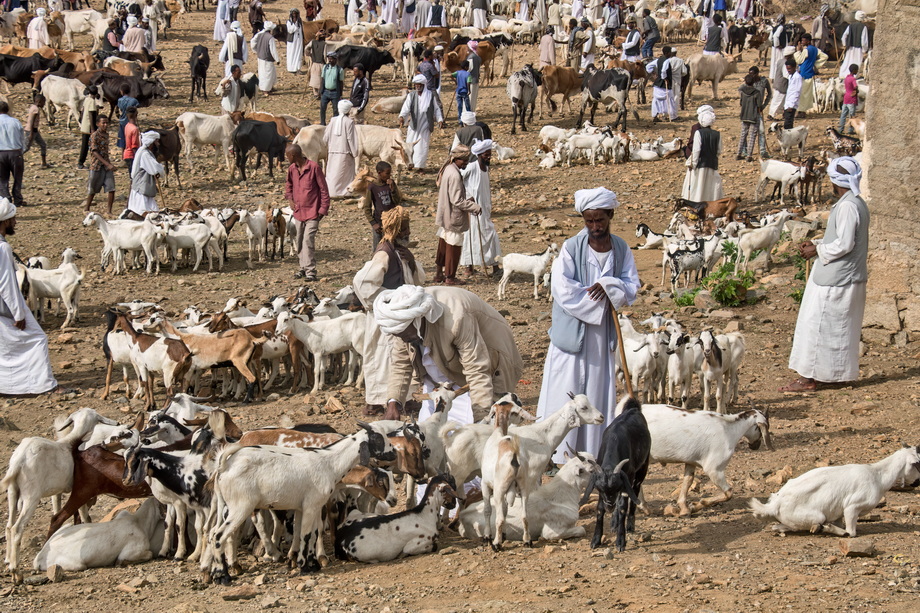
Even though the traditional holidays celebrated in most clans of the Tigre show similarities, some minor differences, mainly due to geographical distances, can be detected in the manner, style or intensity of celebrating the same holidays.
The most common traditional holidays are, child circumcision, name giving, initiation rites and investment. Pagomen or intercalary days, the completion of Koranic school for a child, the feats of Rab’at and the appearance of plague and draught are celebrated among the Marya, Mensae and Beni-amer respectively.
Child circumcision has religious origins. However, it is celebrated in a traditional way for male and female, with more attention given to male circumcision. In most villages during the male circumcision, small banquets are held in honour of friends and relatives. When this is over, the circumcision is performed.
Most Eritreans lead their livelihood by farming and cattle herding and generally consume what they produce. Almost all members of the Tigre ethnic group are traditionally nomads. Cattle are considered symbols of wealth and are therefore not reared for food.
The Tigre use more milk in their diet than anything else and consume meat only occasionally. Among the Tigre, women prepare the food. Sorghum porridge is their main food, accompanied by dairy products. It is forbidden for the wife to eat with her husband. The husband eats with his adult male children, while the wife eats with her daughters and small children.
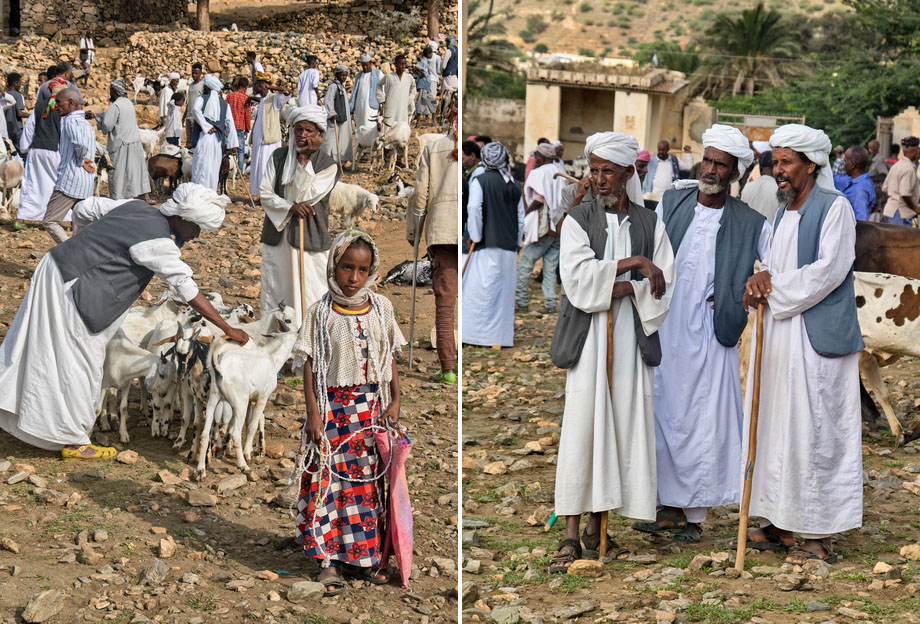
Ritualised incisions of the skin of the eyebrows and of the cheeks are widely practiced among the Tigre. Although the incisions on the eyebrows, Adkatat, have medical motives, intended to cure inflammation or infection of the eye, those on the cheeks, M’shelak, are performed for ritual or aesthetic reasons only.
The most common hairstyles found among Tigre women are called fegiret and qedamit. These hairstyles consists of small micro-braids that run sideways and straight back to the nape of the neck. Fegiret also features seven strands of braids grouped together into two separate areas that cover the forehead slightly.
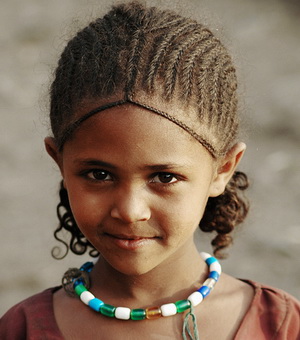

HistoryThe Tigre are a nomadic agro-pastoralist community living in the northern, western, and coastal highlands of Eritrea (Gash-Barka, Anseba, Northern Red Sea regions of Eritrea and other regions too), as well as areas in eastern Sudan. The Tigre speak the Tigre language, which belongs to the Semitic branch of the Afroasiatic family. They are not ethnically homogeneous; diversity is mainly along familial and clan lines. The Tigre ethnic group is broken into the Beni-Amer, Beit Asgede, Ad Shaikh, Mensa, Beit Juk, and Marya peoples. The original speakers of the Tigre language were mainly Christian, reflecting cultural exchange with neighboring Ethiopia. The first Tigre converts to Islam were those who lived on islands in the Red Sea and adopted Islam in the 7th century during the religion's earliest years. |
 |
Mainland Tigre adopted Islam much later on including as late as the 19th century. During World War II, many Tigre served in the Italian Colonial army, part of the period of Italian Eritrea.
The Tigre are closely related to the Biher Tygrinya of Eritrea, as well as the Beja (particularly the Hadendoa). There are also a number of Eritreans of Tigre origin living across the Middle East, North America, the United Kingdom and Australia.
LanguageThe Tigre language is an Afroasiatic language of the Semitic branch. Like Tigrinya, it is a member of the Ethiopian Semitic group, and is similar to ancient Ge'ez. There is no known historically written form of the language. The Eritrean government uses the Ge'ez writing system (an abugida) to publish documents in the Tigre language. Tigre is the lingua franca of the multi-ethnic lowlands of western and northern Eritrea, including the northern coast. As such approximately 75% of the Western Lowlands Eritrean population speaks Tigre. Since around 1889, the Ge'ez script (Ethiopic script) has been used to write the Tigre language. Tigre speakers formerly used Arabic more widely as a lingua franca. Due to most Tigre speakers being Muslim, the language is also written in the Arabic alphabet. The Tigre people, language and their area of inhabitation should not be confused with that of the Tigrayans, who live in northern Ethiopia and the Biher-Tigrinya who live in the central Eritrean highlands, both of which speak varying dialects of Tigrinya, a closely related Semitic language. |
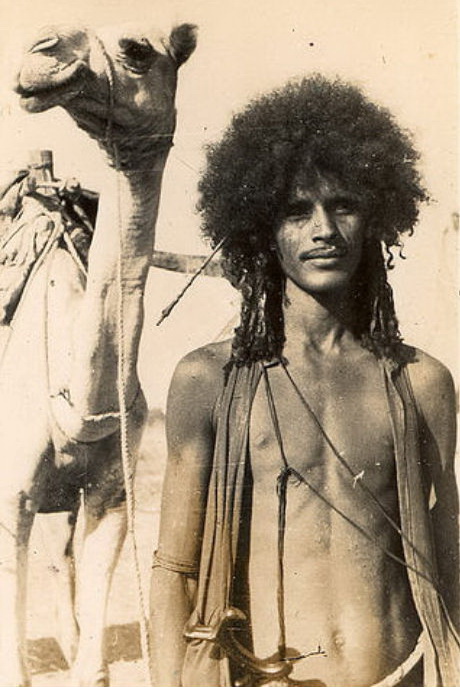 |
These two were brothers, but they parted from each other. And now they have become two tribes; and they are called the two Mänsa’, or the two Haygat. Their language is Tigre only. Their living is from live stock [viz. cows and goats], and from tilling the soil. But nowadays they have not much cattle, and they live by ploughing. Their religion was formerly Christianity, and each had a church, and priests. But, later on their (last), priests did not know how to read.. Then the Mohammedans came to their country and converted them to Islam. And the majority of them became Mohammedans: a few, however, are Christians up to this day. Each of them has a village as its living place; and this village is not moved [like the camps of the nomads]. But sometimes they change the place of their villages. The village of the, Bet-'Abrehe was formerly at Haygat. And later on it [was] moved from Haygat to Gäläb.
And the village went down from Gäläb twice: the first time it was located at Tasasa. The second time, however, it went down to Laba; and .. a is still ..(call)ed Deman-degge (i. e. ruins of the village). On the
other hand, it went (up) to 'Ag’aro, once. And later on it moved from there to Dangura. After this it returned to Gäläb, and there it is up to this day. The houses of the village [which], they build [are] qesasa (huts, Fig. 23) and seqlö (round houses,); and within they make a small interior house of mats. When they move about they put their loads on oxen and mules and donkeys.
The village of the Bet-Sahaqan however, was in former days at Hamhem. Then it moved to the bushes of
Mehélab, and there it is up to this day. Their houses and their pack animals are like those of the Bet-'Abrehe. But. now the village of Mehélab is shifting gradually to another place because the water is now far from them.
The Red Marya and the Black Marya are brothers. And the ancestors of the two Marya and of the two
Mänsa were brothers: they were called Maryu and Mansu. Later on they parted from each other and
each one of them grew into two divisions: Thus the Red Marya and the Black Marya were separated
from each other and each one of them lived in its [own] village and in its [own] country. And now they
are called the two Marya, or the Red and the Black Marya. Their language is Tigre only. Their living is
from cattle; but they plough a little also. Their religion was formerly in their ancestors time, Christianity.
But afterwards they were converted to Islam, and they are all Mohammedans now. They have their
dwelling places each on his field. And they live together by twos and threes; that is to say, those whose
lands are near each other live together. In this way their villages are scattered, and each one of them lives
near his land. And they build huts (qesasa). Their beasts of burden are oxen, donkeys and a few mules.
The ancestor of these three was Asgade. 'Asgade came down from the highland of Kabasa. Some say,
'Asgade started from the Tigray (1) country, and on his way to this p (our) country he halted in the
country of Bet-Tosem (DacchiToscim) at ‘Ad Nefäs. Later on he left 'Ad Nefäs and went down to this
region where his descendants live now. But the brother of 'Asgede stayed at ‘Ad Nefas. And for this
reason the ancestor of t he Three Maflas and the ancestor of 'Ad Nefas are brothers. And the descendants
of the people of Asgade and of his brother who stayed in the Tigray country are there up to this day: they
are called the sons of Asgade. But some say: the country of Asgade- is 'Ad Nefas, and from there Asgade
came down, and his brothers stayed there. And later on 'Asgade begat Maflas. And Maflas begat Hebtes and Takles and 'Abib, The descendants of
Hebtes are the Habab: a part of the Habab live on this side of the frontier [between the English territory
and the Italian colony], and another part beyond. The descendants of Takles are the 'Ad Takles. 'Abib
was the father of the 'Ad Temaryam. And 'Ad Hebtes - or Habab 'Ad Takles and 'Ad Temaryam are
together called the Three Mafläs, and also the Three Habab. The language of all of them is Tigre; the
religion of all of them was originally Christianity.For even the ‘Ad Hebtes used to have a church and a tabot and priests. Then Kantebay Gaweg was
converted to Islam, and he said to the priest: 'Break the tabot." And the priest said: “I dare not break the
tabot of Mary." And Kantubay Gäweg took the tabot himself and chopped it with an ax. Then even the
priests became Mohammedans, and all their descendants are up to this day sheks of the tribe.
And all the people of the Three Maflas embraced Islam, and they are all now Mohammedans.
Their living is from live stock, camels, goats and sheep. Their houses are of mats; but in their villages they
also put branches with leaves on their huts. Their villages move to the lowlands and to the highlands;
and their animals pasture at a place that is as far as day's journey distant from them. And men bring the
milk from the herds and flocks to the village; or else, each one keeps some of his animals that give milk
near the village. When they move, they put their loads on camels and oxen and donkeys, and sometimes
mules. But before their villages move they send first their furniture ahead to the place where they are to
go, And their villages are located [always] at the same place in the highlands, and again in the lowlands.
The village of the 'Ad Hebtes is located at Naqfa, when it is in the highlands, and at 'Algena or WadGän, when it is in the lowlands. The village of the 'Ad Takles [, however,] has no certain places; but
generally it is located at 'Ede-'Atba, when it is in the highlands, and at Habarö, when it is in the
lowlands. And the village of the ‘Ad Temaryam is located at 'Af-'Abad, when it is in the highlands, and
at 'Äkät, when it is in the lowlands. The people of the Three Maflas do not know how to plough. But a
few of the bondsmen of the ‘Ad Temaryam do plough a little. And the Three Maflas buy the corn from
the Two Mänsa', from the Bét-Guk and from the Belen. Or else, they buy corn and rice from Massaua.
i) I.e. the province generally known by its Amharic name Tigre.
Their ancestor came down from Kabasa. And some say that the ancestor of the Bet-Guk was a relative of
'Asgäde; and for this reason the Bet-Guk and the Three Maflas are akin to each other. Some again say
that the ancestor of the Bet-Guk, Kantebay Gäribruk - Zär'i-Beruk -, came down from Wakki, (1) and
that the descendants of his brothers are there up to this day. The language of the Bet-Guk is Tigre. Their
religion was formerly Christianity, but now they have embraced Islam. Their living is from ploughing and
from live stock (cows and some goats); but now they have not much cattle: they live by ploughing. Their
village is Wäzent'a't: their houses are qesasa. The ancestor of these three was Asgade. 'Asgade came
down from the highland of Kabasa. Some say, 'Asgade started from the Tigray (1) country, and on his
way to this p (our) country he halted in the country of Bet-Tosem (DacchiToscim) at ‘Ad Nefäs. Later on
he left 'Ad Nefäs and went down to this region where his descendants live now. But the brother of
'Asgede stayed at ‘Ad Nefas. And for this reason the ancestor of t he Three Maflas and the ancestor of
'Ad Nefas are brothers. And the descendants of the people of Asgade and of his brother who stayed in the
Tigray country are there up to this day: they are called the sons of Asgade. But some say: the country of
Asgade- is 'Ad Nefas, and from there Asgade came down, and his brothers stayed there. And later on 'Asgade begat Maflas. And Maflas begat Hebtes and Takles and 'Abib, The descendants of
Hebtes are the Habab: a part of the Habab live on this side of the frontier [between the English territory
and the Italian colony], and another part beyond. The descendants of Takles are the 'Ad Takles. 'Abib
was the father of the 'Ad Temaryam. And 'Ad Hebtes - or Habab 'Ad Takles and 'Ad Temaryam are
together called the Three Mafläs, and also the Three Habab. The language of all of them is Tigre; the
religion of all of them was originally Christianity.
For even the ‘Ad Hebtes used to have a church and a tabot and priests. Then Kantebay Gaweg was
converted to Islam, and he said to the priest: 'Break the tabot." And the priest said: “I dare not break the
tabot of Mary." And Kantubay Gäweg took the tabot himself and chopped it with an ax. Then even the
priests became Mohammedans, and all their descendants are up to this day sheks of the tribe.
The language of these three is Tigre only. The people of the Mawatte' are of different origins: some of
them are of Balau origin; and some of them are 'Asraf. (1) And besides these that are named there are
found a few others. The religion of all of them is Islam. Their living is from camels, cattle, goats and
sheep; a few of them, however, plough. Their houses are ma'ddani [i. e. square houses of wood and
branches, Fig. 25] and qesasa. These three do not move about. Their beasts of burden are camels, oxen,
donkeys and a few mules. The place where they buy and purchase everything is Massaua.
The language of these people also is Tigre. But the Tigre of the Nabara is not pure: it is between Tigre and Tigrina. They used to be counted formerly with the Moté'at; but now they are by themselves. Their living is from cattle and goats, and from ploughing. Their houses are of mats and of branches. Their beasts of burden are oxen and mules and donkeys. They live in the Moté'at country; their religion is Islam.
Their language is Tigre. They say that they are originally related to the Assaorta. The living of the
Mäshallt - from sahel [i. e. the coast] - is from cattle, goats, sheep and a few camels; they work also at
Massaua. They have no village: they are nomads and roam about, following their herds. Most of the time
they live in the plain. The religion of all of them is Islam. Their houses are of mats. When they move they
put their loads on oxen, donkeys, mules and camels. The only corn they eat is bought: they do not plough.
Their only country is Waqiro [in the plain, 1/2 day's journey westward of Hetemlo).
Those who live at 'Emkullu, Hetemlo, at Massaua, at Dakano - or Hergigo [i. e. Archico]- all speak the Tigre language. But most of them have also learned Arabic. They are all Mohammedans. They are of different origins, but their leaders are mostly of Balau origin. Their living is from trading. Their houses are ma'ddani, qesasa and merabba' [i. e. stone-houses].
Their language is Tigre only. They are all Mohammedans. They are of different origins, and they used to
be counted with the Möte’at people. The ‘Ad Suma, however, are related among themselves. The ancestor
of the ‘Ad Suma had married a woman called S(h)uma; then he begat a few sons of her and died. And
Suma reared her children, and she was very brave and well known. And afterwards, when her children
had their own houses they were called 'Ad Suma. And they are called up to this day 'Ad Suma after the
name of their ancestress. The only corn they eat is bought. Their houses are of mats. And they roam about
following their herds everywhere. Their beasts of burden are oxen and mules and donkeys.
The language of these [peoples] is Tigre. They are all Mohammedans. The ancestor of the 'Aflanda came
as a Mohammedan from the sea on the road of the Gash river. (1) And some of his descendants live in the
Barka country; some in the Habab country, some in the country of the Two Mänsa'; some, again, live at
Suakin - or Kar [near Suakin] -. The Wayra live in the Moté’at country, everywhere. The living of these
people is from cattle, camels, sheep and goats. And they roam about everywhere following their herds.
Their houses are of mats. And their beasts of burden are camels, oxen, donkeys and mules. And they eat
the corn which they buy from everywhere.
Perhaps Suakin-Chartoum-Kassala.
The language of all of them is Tigre. They are all Mohammedans. The Saura and the ‘Ad Ma'allem used to be counted with the ‘Ad Temaryam: but now they are counted by themselves, and each of them has its own village. The 'Asfa'da used to be counted with the Habab, but now they are separated from them (and live] by themselves. All these [three tribes] call their village zaga. And the zagas of the Saura and the 'Ad Ma'allem go up and down in the country of the 'Ad Temaryam. And even the 'Asfada live there with their zaga and go up and down. The houses of the zagas are of mats. Their beasts of burden are camels, oxen, donkeys and a few mules. Their living is from camels and cattle. And they buy corn from other countries.
Their language is Tigre. And they are all Mohammedans. Their living is from camels, cattle, sheep and
goats. Their country is between the Habab and the 'Ad Temaryam. And their village is called Zaga ‘Ad
Sek. They go down to the lowlands and up to the highlands; their beasts of burden are camels and oxen
and donkeys. And the houses of the zaga are of mats. And the only corn which they get is that which
they buy.
They are sometimes called also by the name of their chief, e. g. 'Ad Sek'Alamin formerly, and now 'Ad
Sek-'Amar.
The language of all of them is Tigre. They are all Mohammedans. Their ancestors came from the sea at Suakin. And each one of them used to live as a tribe by itself. But later on the Ganifra and the BetBa'asso decreased in number, and they united with the Bet-Ma’ala. And now they are counted with the Bet-Ma’ala. Their living is from camels, cattle, goats and sheep. Their houses are of mats. And they go up and down following their herds. Their beasts of burden are camels, oxen and donkeys.
Their language is Tigre. And their ancestors came as Mohammedans from the sea; and the descendants of them are Mohammedans up to this day. Their living is from ploughing and from cattle. But I do not know much about their villages and their beasts of burden. It is said, however, that they have horses.
Their language is Tigre; hut they know also the language of the Hedarab, or Min-Amer. They are all
Mohammedans. Their living is from camels, cattle, goats and sheep. Their houses are of mats. And, their village is called zaga; and they go down to the lowlands and up to the highlands. Their beasts of burden
are camels, oxen and donkeys. Of the 'Ad Haséri some live on this side of the frontier and some beyond. These are the tribes that know the Tigre language, but whose fathers had another language. These
tribes have a different language of their own country, but they have learned the Tigre language, and some
of them speak it well Belen.
All the people of the Belen country have a language of their own; but, on the other hand, all of them know the Tigre language also. The Belen were originally all Christians, but now half of them have become Mohammedans. Their living is from ploughing and from cattle and goats. Their villages stay each at its place: they do not move. Their houses are [of the] qes'asa kind. Their beasts of burden are oxen and donkeys and mules.
Sources: